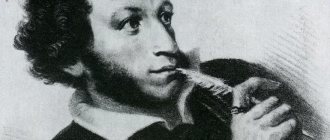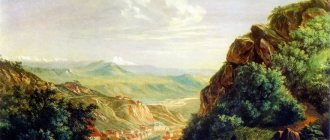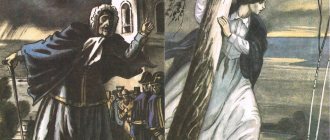The plot of the work
Master Ivan Timofeevich arrived in the remote village of Perebrod on the outskirts of Polesie. On one of his hunting trips, he got lost and came across a lonely, unprepossessing hut in which the witch Manuilikha lived with her granddaughter Olesya, an attractive dark-haired girl of twenty-five years old, who immediately charmed the master with her simple and natural beauty.
Their meetings became regular. Olesya accompanied him through the swamps, demonstrating her supernatural abilities along the way - she cut and healed his hand with a blood spell, and made him stumble out of the blue. The girl also told the master’s fate: he would fall in love with the dark-haired queen of clubs and unwittingly bring terrible grief upon her.
A little later, for several days, Ivan Trofimovich did not come to Olesya due to illness. But the temporary separation only pushed the lovers to confess their feelings to each other. Talk about marriage embarrassed Olesya, because her abilities were supposedly from evil spirits, and the bride would definitely need to get married. Finally, she made up her mind and attended a church service in honor of the holiday. The gathered people could not let her get away with this blasphemy - the witch came to a holy place. Olesya miraculously escaped from the raging women, promising to pay.
At their last meeting, Olesya began to say goodbye to Ivan Timofeevich, but he did not believe that they would part forever. That same night, hail destroyed the entire harvest in the village. They accused, of course, witches. In the morning, the master galloped headlong to the forest hut, but Manuilikha and Olesya had already managed to escape.
Problems of the story
The theme of man and nature is raised in the work along with a whole list of social and moral problems. Each of them is illustrated by Kuprin through conflicts and expressive characters.
The main problems can be identified as follows:
- Tragic love. Mutual feelings between a rootless girl and a nobleman. They are too different - a child of nature and a city man. He cannot stay in Polesie, and even if she agrees to move to the city, she will not last long there.
- Loneliness. Manuilikha and Olesya are forced to live away from everyone, in a “lame and sad” hut in a swamp. But they are lonely because everyone in the village is angry with them, they don’t accept them as their own, they persecute them, they blame them for any random misfortune.
- Intolerance. People fear what they don't understand. The supernatural abilities of Manuilikha and her granddaughter instill fear in people of the inexplicable. The fear is so strong that the old woman and the girl were driven away, and the “damned kublo” - their house - was smashed to pieces.
- Cruelty. It was believed that witches receive powers from the devil, therefore, when Olesya defended the service in the church, the women literally went frantic, already on the street they attacked her in a crowd, beat her, tore her dress, and wanted to disgrace her by smearing her with tar.
- Self-interest. Ivan Timofeevich appealed to the police officer’s mercy so that he would not evict the unfortunate women from the hut. The constable refused, citing official duties and the law, but, having received an expensive gift, he immediately forgot about his principles.
- Education. There was not a single literate person in the entire village. Even the headman could not read what documents he put stamps on. Yarmola asked the master to teach him how to write, so that at least someone could sign for everyone.
Man and nature in the works of Kuprin
Author: Kuprin A.I.
The image of nature is organic to Kuprin’s artistic world and is inextricably linked with his concept of man. One can highlight a number of works by the writer in which nature occupies an important place.
Such are the picturesque Polesie cycle, lyrical miniatures “Woodcocks”, “Night in the Forest”, reflections on natural phenomena - “Empty Dachas” (beginning of autumn), “Golden Rooster” (sunrise).
This also includes a series of lyrical essays about Balaklava fishermen “Listrigons”.
For the first time, Kuprin’s concept of man and nature was recreated as something holistic in the works of the Polesie cycle, which was based on such stories as “The Wilderness of the Forest,” “Olesya,” and “On the Wood Grouse.”
The unity of the cycle is largely due to the image of the narrator-hunter, through whose perception nature is depicted and who perceives it as a real and at the same time mysterious and enigmatic world, worthy of observation and comprehension, and equivalent to the human world in the general flow of existence.
The feeling of connection and kinship with this world causes the hero’s excitement: “he held his breath and froze,” “cautiously,” “trying not to make noise,” “he peered,” etc. Contact with the natural world becomes for the narrator not only an attempt to get closer to the mystery of the world , but also a way of moral purification.
Nature helps him forget about everyday troubles and worries and plunge into a new stream of time. Kuprin's sense of nature is cosmic. The writer perceives it as an organic whole that has a direct connection with the human world.
Left alone with nature, Kuprin's narrator experiences moments that allow him to feel the movement of time, which give a person the feeling of being included in the eternal flow of cosmic life. The winter landscape in the story “Olesya” takes on a philosophical coloring: “It was as quiet as it can be in the forest in winter on a windless day.
Lush lumps of snow hanging on the branches pressed them down, giving them a wonderful, festive and cold look. From time to time a thin branch would fall from the top, and you could hear very clearly how, as it fell, it touched other branches with a slight crack. The snow turned pink in the sun and turned blue in the shade.
I was overcome by the quiet charm of this solemn, cold silence, and it seemed to me that I felt time slowly and silently passing by me...” At the moment of communication with nature, Kuprin’s hero-storyteller is able to see the eternal in the momentary, to feel his participation in the whole. At this moment, the hero realizes himself as part of the Universe, embodied in the image of silence and silently flowing time, which give rise to a feeling of world harmony (“something harmonious, beautiful and tender”).
The image of nature is poeticized in “Oles”. Kuprin gives the hero the look of an artist, the ability to reveal the beauty of the world and see it where, it would seem, there is nothing remarkable.
Thus, describing a forest road “black with mud” during the spring thaw, the hero notes that in the water, which was filled with numerous ruts and traces of horse hooves, “the fire of the evening dawn was reflected.”
The hero sees nature as a fairy tale, magic, merging the beauty of a moonlit night and the mystery of love into a single beautiful moment of life: “And this whole night merged into some kind of magical, enchanting fairy tale.
The moon has risen, and its radiance is fancifully variegated and mysteriously colored the forest, lying among the darkness in uneven, bluish-pale spots on gnarled trunks, on curved branches, on moss soft, like a plush carpet. Thin trunks of birches turned white sharply and clearly, and on their sparse the foliage seemed to be covered with silvery, transparent, gaseous covers. And we walked, hugging, among this smiling living legend, without a single word, overwhelmed by our happiness and the silence of the forest.”
The problem of the relationship between man and nature is raised by Kuprin in the series of essays “Listrigons”, which emphasize the connection of man with natural life, the subordination of the work of fishermen to natural natural rhythms. The image of nature in “Listrigons” is emotionally charged. In descriptions of the night, sea, silence, starry sky, etc.
The author often uses evaluative epithets, comparisons, and personifications. Kuprin shows in his work that the break between man and nature leads to the loss of cosmic connections and the inferiority of existence.
Kuprin's hunting stories and descriptions of nature are presented to the reader as one of the attempts of modern man to restore the cosmic worldview, so relevant for our era.
Image of Olesya
The main character of the story, the girl Olesya, is inextricably linked with nature. She grew up far from civilization, has never been to a large city, and cannot read or write. At the same time, she is an energetic person, with a strong character, kind by nature, but also capable of standing up for herself. The narrator admits that the Polesie forest instilled pride and independence in her.
Olesya is not afraid to live among marshy swamps surrounded by forests; she knows her bearings perfectly. This is her home, her element, her world. Even his and his grandmother’s home is distinctly fairy-tale-like - a hut on chicken legs (that is, on stilts, so as not to be flooded during a flood). Olesya loves and pities animals, which is clearly demonstrated in the scene when she brings small hungry finches into the house and places them on the stove, where the starlings already live.
The girl is illiterate, communicates almost only with her grandmother, but she still cannot be called stupid. She is exposed to “unconscious, instinctive, strange knowledge, which is often ahead of science, mixed with superstition and kept among the people as the greatest secret.”
Olesya’s ability to charm blood and foresee the future comes from nature, and not from the devil, as she sincerely believes.
The girl is guided not by scientific knowledge, not by someone else’s opinion, but by intuition, natural instinct, and her own feelings. This is more than enough for her to live in joy, only people disturb the idyll (village residents blame for any misfortune, the policeman threatens to send her grandmother to prison, even the main character inadvertently brings misfortune on Olesya).
The narrator mentions that the appearance of the beautiful witch forever merged in his memory with natural images: “flaming evening dawns,” birdsong, “fragrant lilies of the valley and honey in the morning.” Both Olesya’s beauty and love are pure and natural. She is so far from affectation, coquetry and calculating cunning.
Man and nature in the works of Kuprin
For the first time, Kuprin’s concept of man and nature was reproduced as something holistic in the works of the Polesie cycle, which was based on such stories as “The Wilderness of the Forest,” “Olesya,” and “On the Wood Grouses.”
The unity of the cycle is largely due to the image of the narrator-hunter, through whose perception nature is depicted and who perceives it as a real and at the same time mysterious and enigmatic world, worthy of observation and comprehension, and equivalent to the human world in the general flow of existence
The feeling of connection and kinship with this world causes the hero’s excitement: “clouding his breath and dimension”, “carefully”, “trying not to make noise”, “was surprised”, etc. The collision with the natural world becomes for the narrator not only an attempt to get closer to the mystery of the world, but also an image of moral purification. Nature helps him forget about life's chaos and worries and immerse himself in a new flow of time.
Kuprin's sense of nature is cosmic. The writer perceives it as an organic whole that has a direct connection with the human world. Left alone with nature, Kuprin's narrator experiences moments that allow him to feel the movement of time, which give rise to a person's feeling of being included in the eternal flow of cosmic life.
The winter landscape takes on a philosophical coloration in the story “Olesya”: “It was as quiet as it can be in the forest in winter on a windless day. Hanging on the areas, a lush pile of snow pressed them down, giving them a wonderful, festive and cold look.
From time to time a thin branch fell from the top, and it was extremely clearly heard how, as it fell, it touched other areas with a slight crack. The snow turned pink in the sun and blue shadows.
READ ALSO: Postmodernism in literature
I was overcome by the quiet charm of this pure, cold silence, and it seemed to me that I felt time slowly and silently passing by me...
“At the moment of communication with nature, Kuprin’s hero-storyteller is able to see the eternal in the momentary, to feel his involvement in the whole.
At this moment, the hero realizes himself as part of the Universe, embodied in the resentment of silence and silently flowing time, which give rise to a feeling of world harmony (“something harmonious, beautiful and tender”).
The image of nature is poeticized in “Olesevi”. Kuprin gives the hero the look of an artist, the ability to reveal the beauty of the world and see it where, it would seem, there is nothing remarkable.
Thus, describing a forest road “black with mud” during spring off-road conditions, the hero notes that in the water, which was filled with numerous ruts and traces of horse hooves, “the fire of the evening glow was fought off.”
The hero sees nature as a fairy tale, magic that merges the beauty of a monthly night and the mystery of love into a single beautiful moment of life: “And this whole night merged into some kind of magical, magical fairy tale.
The month had passed, and its radiance, fancifully variegated and mysteriously colored the foxes, lay among the darkness in unequal, bluish-pale spots on gnarled trunks, on arched branches, on mosses, soft as a plush carpet. Thin trunks of birches turned white sharply and clearly, and on their sparse the foliage seemed to be draped with silver, piercing, gasping, and crooked
And we walked, hugging, among this smiling living legend, without a single word, overwhelmed by our happiness and the silence of the forest.”
The problem of the relationship between man and nature is raised by Kuprin in the series of essays “Listrigoni”, which emphasizes the connection of man with natural life, the subordination of the work of fishermen to natural natural rhythms. The image of nature in “Listrigons” is emotionally colored. In descriptions of the night, sea, silence, starry sky, etc.
The author often uses evaluative epithets, comparisons, and personifications. Kuprin shows in his work that the break between man and nature leads to the loss of cosmic connections and the inferiority of existence.
Kuprin's hunting plots, descriptions of nature revealed to the reader as one of the attempts of modern man to restore the cosmic worldview, so relevant for our era
There are so many wonderful feelings on earth!
But the most precious and uplifting thing is, undoubtedly, love! Every poet and writer writes his works in order to open people's eyes to what they do not see or do not want to feel.
Love is beautifully shown in Kuprin’s work “The Garnet Bracelet,” the love of a poor telegraph operator for a rich and noble lady.
This is how fate returned! Poor Zheltkov’s love was not a passing infatuation, but some truly enormous feeling that can be tested by each of us
It all really started just jokingly, but ended with what happened to Zheltkov after the seme of endless years. But then Zheltkov decides to take an action, a little incomprehensible, but still uplifting and beautiful.
Despite his poverty, he gives Vera a bracelet that is very dear to him. But Vera does not understand this act and tells everything to her man, who was naturally offended by this. He takes this as a challenge and goes to sort things out with Zheltkov.
But what kind of offended man is this if he does not go to meet his opponent alone?
This parish served as the impetus for Zheltkov’s suicide. He understands that he will never achieve Vera’s love and, deciding not to complicate her life, kills himself. Vera decided to see a man who, in her opinion, was simply delighted with her, but when she comes to where Zheltkov lived, when she sees this beautiful open face, she realizes that she has lost
Any woman dreams of such love all her life. And Vera, through her favor towards a man, because it was only favor, loses what she may have been waiting for all her life.
I liked this work because it reflects all the complexity and ambiguity of human love, its impossibility in the world of social and caste differences, and I think that Kuprin resorted to showing its beauty and strength.
Love is beautiful, everyone who has ever experienced this feeling knows this. But for those who have not yet conceived it in their soul, do not be upset! More to come! Just believe it!
Man and nature in the works of Kuprin
Two worlds collide
Conflict is one of the best ways to reveal a specific problem in a story. Of course, there is no direct confrontation between Olesya and Ivan Timofeevich in the story, but through their relationship one can clearly see the clash of two polar opposite worldviews.
They come from different environments with completely different upbringings. He does not understand her mystical horror of mysterious forces, the inevitability of fate, and is surprised how she is not afraid of living away from people, and she would never exchange her native wilderness for secular Petersburg. In addition, the contrast can also be seen in some other circumstances:
- Ivan Timofeevich is engaged in literary art, and Olesya is a completely uneducated and illiterate girl;
- he spends his leisure time hunting, kills animals out of boredom, and she loves birds and animals, takes pity on them, admits that they also want to live;
- She explains her unusual abilities with mysticism, and he tries to find a scientific basis for them.
Olesya is inseparable from nature, and both understand this. A big city is a scary place for a girl. Speaking about city life, Ivan Timofeevich exposes all its unnaturalness. Perhaps it was Olesya who helped him look at the long-familiar world from a new angle , to see its unsightly side: people in the city’s “little kennels” are cramped, stuffy, some don’t see the sun for a long time, they live in damp basements, locked in apartments, “for sure.” birds in cages."
The narrator cannot imagine how the sweet Polesie witch would conduct small talk in the living room and dress up in fashionable dresses. Polite hypocrisy and the subtle rules of high society are alien to her and incomprehensible. To tear Olesya out of the bosom of nature and transport her to the city means to destroy her with her own hands, like cutting off the roots of a tree.
Through the image of Olesya, Kuprin shows that a person who has lived from childhood far from civilization, avoids the company of people, and has not been trained in secular manners is not necessarily a tactless savage and ignoramus. Living in unity and harmony with nature bestows knowledge that cannot be obtained from books, and skills that are difficult to explain, even if you own them.
Despite all her lack of education and unsociability, Olesya grew up with a sensitive, kind and brave heart, with an inquisitive and sharp mind.




